Dodge Dakota
The Dodge Dakota, known as the Ram Dakota for the final two years of production, is a mid-size pickup truck from Chrysler's Ram (formerly Dodge Truck) division. From its introduction through 2009, it was marketed by Dodge. The first Dakota was introduced in 1986 as a 1987. The Dakota was nominated for the North American Truck of the Year award for 2000. The Dakota has always been sized above the compact Ford Ranger and Chevrolet S-10, but below the full-sized pickups such as Dodge's own Ram. It is a conventional design with body-on-frame construction and a leaf spring/live axle rear end. The Dakota is the first mid-size pickup with an optional V8 engine. Dakotas have been used by police and fire departments, as off-road vehicles, patrol trucks, or even brush trucks.
| Dodge Dakota | |
|---|---|
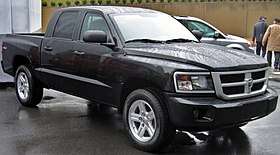 | |
| Overview | |
| Manufacturer | Chrysler Corporation (1986-1998) DaimlerChrysler (1998-2007) Chrysler LLC (2007-2009) Chrysler Group LLC (2009-2011) |
| Also called | Ram Dakota (2009-2011) |
| Production | 1986–2011 |
| Model years | 1987–2011 |
| Assembly | Warren, Michigan, United States Campo Largo, Paraná, Brazil (1998-2001) |
| Body and chassis | |
| Class | Mid-size pickup truck |
| Layout | Front engine, rear-wheel drive / four-wheel drive |
| Chronology | |
| Successor | Jeep Gladiator |
First generation (1987–1996)
| First generation | |
|---|---|
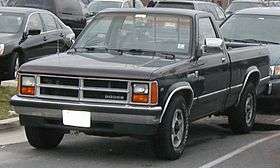 | |
| Overview | |
| Production | 1986–1996 |
| Model years | 1987–1996 |
| Body and chassis | |
| Body style | 2-door pickup truck 2-door convertible 2-door extended cab |
| Related | Shelby Dakota |
| Powertrain | |
| Engine | 2.2 L (134 cu in) K I4 2.5 L (150 cu in) K I4 2.5 L (150 cu in) AMC I4 3.9 L (238 cu in) LA/Magnum V6 5.2 L (318 cu in) LA/Magnum V8 |
| Transmission | 3-speed automatic 4-speed automatic 5-speed manual |
| Dimensions | |
| Wheelbase | 111.9 in (2,842 mm) 123.9 in (3,147 mm) 130.9 in (3,325 mm) (ext. cab) |
| Length | 1987–1990: 185.9 in (4,722 mm)/204.4 in (5,192 mm) 1989–1990 Club Cab: 211.1 in (5,362 mm) 1991–93: 184.2 in (4,679 mm)/202.7 in (5,149 mm) 1991–93 Club Cab: 203.2 in (5,161 mm) 1994–96: 195.3 in (4,961 mm)/213.8 in (5,431 mm) 1994–96 Club Cab: 214.3 in (5,443 mm) |
| Width | 1987–88: 68.4 in (1,737 mm)/68.1 in (1,730 mm) 1989–1996: 69.4 in (1,763 mm) |
| Height | 1987–1990: 64.2 in (1,631 mm)/67.1 in (1,704 mm) 1989–1993 Club Cab: 64.7 in (1,643 mm) 1991–93 Club Cab 4WD: 67.7 in (1,720 mm) 1994–96 4WD: 67.3 in (1,709 mm) 1994–96 Club Cab 4WD: 68.5 in (1,740 mm) 1994–96 2WD: 65.0 in (1,651 mm) 1994–96 2WD Club Cab: 65.6 in (1,666 mm) |
The Dodge Dakota was developed by Chrysler as a mid-sized pickup. To keep investment low, many components were shared with existing Chrysler products and the manufacturing plant was shared with the full-sized Dodge D and W Models. The first generation of the Dakota was produced from 1986 through 1996 (for the 1987 to 1996 model years). It was slightly updated for the 1991 model year. Inline-four and V6 engines were offered along with either a five-speed manual or three-speed automatic transmission. Four-wheel drive was available only with the V6. Both 6.5- and 8-foot beds were offered. Fuel injection was added to the 3.9 L V6 for 1988, but the output remained the same.
In 1988, EFI was added to the V6. Power windows and locks were now optional. The sport package was added as a mid-year release. Exterior colors came in black, bright white, and graphic red. Available in both 2WD and 4x4, the sport included:
- AM/FM stereo radio with cassette player
- Carpeted logo floor mats
- Center armrest bench seat
- Charcoal-silver deluxe cloth interior with fold-down arm rest
- Color-keyed leather-wrapped sport steering wheel
- Deluxe wipers
- Dual remote control outside mirrors
- Floor carpet
- Gauge package
- Mopar air dam with Bosch fog lamps
- Mopar light-bar with Bosch off-road lamps (4x4 only)
- Unique bodyside tape stripes
- Euro-style black out grille and bumpers
- Sliding rear window
- 3.9 liter V6 engine
- 15" aluminum wheels
The N-body platform was the result of operational efforts by Harold K. Sperlich, who was in charge of Chrysler's product planning in the early 1980s, in which Japanese-inspired compact pickups of the time lacked the size and features necessary to meet the demands of American buyers. In the late-1970s, Chrysler was still recovering from their near-bankruptcy and resources were in short supply. Sperlich challenged the N-Body team to search for all opportunities to reuse existing components to create the Dakota. The resulting highly investment-efficient program enabled Chrysler to create an all-new market segment at low cost. Key individuals involved in making this product a reality included Glenn Gardner, Glen House, Robert Burnham, Don Sebert, Jim Hackstedde, and Clark Ewing. The basic Dakota vehicle was ultimately used as a foundation to create the Dakota extended cab version and the Dodge Durango SUV.
Additional options found in first-generation trucks:
- Lowered suspension
- 15-inch chrome rims
- Chrome bars along the beds
- AM/FM stereo with cassette, and (optional) CD players* Sliding rear windows
- Chrome bumpers
- V8 engines
- Infinity sound systems
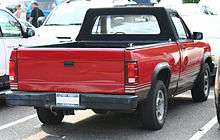

For 1989, the unusual Dakota convertible was rolled out. It featured a fixed roll bar and a simple manual top. Roughly 2,482 were sold that first year. The idea came from Jerry York and they were manufactured by ASC (American Sunroof Company, now known as American Specialty Cars).[1] Another important addition that year was Carroll Shelby's V8-powered Shelby Dakota, his first rear-wheel drive vehicle in two decades.
An extended "club cab" model was added for 1990, still with two doors. This model allowed the Dakota to boast capacity for six passengers, though the rear seat was best suited for cargo, children, and shorter adults.
In 1990, the front of the 1991 Dakota received a new grille and hood which extended the engine compartment to better fit the optional 170 hp (127 kW) 5.2 L V8, which was inspired by the earlier Shelby Dakota V8 option. By the end of 1991, the standard square sealed-beam glass headlamps were phased out for the aerodynamic-style molded plastic headlamps attached to the grill components. It was equipped with halogen lights, making 1991 the only model year for a unique front-end for the Dakota, though it is mechanically possible to fit sealed beams on 1992 to 1996 model years, as this model year was an overlap between new grille introduction and new headlamp introduction. Also debuting on 1991 models were six-bolt wheels (replacing the earlier five-bolt wheels) based on Dodge's marketing attempting to differentiate the Dakota from competing manufacturers' trucks and the upcoming introduction of the redesigned Ram, and the last year for the Dakota convertible.
To fulfill the Dodge division's commitment to the American Sunroof Company (which was responsible for the modifications to these trucks), production of the "drop top" Dakota was extended into the 1991 model year. Production was extremely limited, with just eight produced in total, making them the most rare of all Dakotas. Unlike the previous years, colors and options varied more than before, as the manufacturer picked each of these trucks in a somewhat random fashion. No advertising was given to these trucks, and they do not appear in sales literature. This is most likely because the majority of them were sold before getting to their dealer lots.
Both of the 90 degree V-configuration engines were updated to Magnum specs the next year, providing a tremendous power boost. Along with the introduction of the Magnum engine came multiport electronic fuel injection (EFI). The EFI computer (called a PCM by Chrysler) was partially responsible for the improved performance. The new engine/computer combination produced about 230 hp (172 kW)
The 1994 model year had a few minor changes, with the most notable being the addition of a standard driver's-side airbag, located in a new, two-spoke design steering wheel (also found in the Ram). Other changes included the discontinuation of the "SE" and "LE" trims. In following with the all-new Ram full-sized pickups, the top-end trim was renamed to "SLT", with these models (along with select others) wearing the new chrome finished, styled six-bolt steel wheels styled similar to the five-bolt type found on the larger Ram. Other changes included revisions to color and overall trim options. SRS airbags were also added for 1994. A CD player became optional, as did a combination cassette player and CD player unit. Leather seats were also available on LE models. New alloy wheels were available.
In 1995, the first generation's final model year of 1996, the base K-based 2.5 L SOHC I4 engine option was out of production and had been considered vastly underpowered compared to the competition, so Dodge replaced it with another 2.5 L I4 engine; this being of American Motors heritage with an OHV valvetrain and rated at 120 hp (89 kW). This was the only major change for 1996, and the AMC 2.5 L would also be carried over as the base engine in the new, larger 1997 model.
Li'l Red Express Dakota and Dakota Warrior
Two special editions of the first were constructed with step-side beds. Both were constructed by L.E.R. Industries of Edwardsburg, Michigan. The step-side beds were constructed out of fiberglass and galvanneal.[2] Wooden bed rails were also available.[3]
The Li'l Red Express Dakota was made to resemble the original Express, which was based on the Dodge D-Series. It featured the classic-looking step-side bed and also had dual vertical exhaust stacks just behind the cab, which were purely cosmetic (though they could be made to be functional). The Dakota Warrior was made to resemble the Warlock trucks of the late 1970s. Warriors featured the same custom bed as the Dakota Express, but lacked the vertical exhaust stacks.[2] Both the Express and Warrior Dakotas had a graphics package made to resemble those of the original Express and Warlock, respectively.[4]
Production numbers for the Expresses and Warriors were very low, in the hundreds.[5] The rarest of those came with the 5.2 L Magnum V8 engine, which was only an option during 1992, the final model year of Express and Warrior.[2]
Models
The 1987-1996 Dodge Dakota came in three basic models:
The Dakota S was the base trim level. It included the following standard features: base vinyl seating surfaces, radio delete package and audio system delete package (later, an AM/FM stereo with a two-speaker audio system became standard equipment on the Dakota model with a two-speaker audio system), a heater with fan control, vinyl flooring, a black front grille and front bumper, full-faced steel wheels, all-season tires, and manual "roll-up" windows and door locks. A black painted back step bumper, air conditioning, AM/FM or AM/FM/Cassette radio, and power steering were extra-cost options. This model was not typically seen as a club cab model, and also was not available with a V8 engine option like the other Dakota models were.
The sport was the mid-range trim level. It added features such as vinyl-and-cloth-trimmed seating surfaces, an AM/FM stereo with a two-speaker audio system, sport-styled steel wheels, body side cladding delete, a tilt-adjustable steering column and wheel, and "sport" interior accents to the base Dakota model. Later, it also added chrome-clad steel wheels, as well as a color-keyed front fascia and front grille, and sport decals that adorned the doors and pickup bed sides of the Dakota. V6 and V8 engines were available on the sport model.
The sport convertible was the only convertible Dakota available, and was only available until the early 1990s, when it was finally discontinued. It added the following features to the mid-range sport trim level: sport-styled alloy wheels, cloth seating surfaces with vinyl inserts and accents, an AM/FM stereo with cassette player and a four-speaker audio system, air conditioning, a manual-folding vinyl convertible roof, and sport decals on the doors of the Dakota. The V6 engine and two-door regular cab was the only available configuration of the sport convertible.
The LE, later renamed SLT was the top-of-the-line trim level. It added features such as cloth seating surfaces, air conditioning, an AM/FM stereo with cassette player and a four-speaker audio system, alloy wheels, body side cladding, carpeted flooring, and power windows and door locks to the mid-range sport model. V6 and V8 engines were available on the LE or SLT models.
Engines
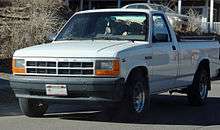
- 1987–1988 - 2.2 L (135 cu in) K I4, SOHC, 97 hp (72 kW)
- 1987–1991 - 3.9 L (238 cu in) LA V6, 125 hp (93 kW)
- 1989–1995 - 2.5 L (150 cu in) K I4, 99 hp (74 kW)
- 1991 - 5.2 L (318 cu in) LA V8, 170 hp (127 kW)
- 1992–1993 - 3.9 L (238 cu in) Magnum V6, 180 hp (134 kW)
- 1992–1993 - 5.2 L (318 cu in) Magnum V8, 230 hp (172 kW)
- 1994–1996 - 3.9 L (238 cu in) Magnum V6, 175 hp (130 kW)
- 1994–1996 - 5.2 L (318 cu in) Magnum V8, 225 hp (168 kW)
- 1996 - 2.5 L (150 cu in) AMC I4, 120 hp (89 kW)
Second generation (1997–2004)
| Second generation | |
|---|---|
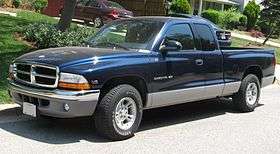 | |
| Overview | |
| Production | July 1996 – July 2004 (North America) 1998–2001 (Brazil) |
| Model years | 1997–2004 |
| Designer | Dennis Myles (1993) |
| Body and chassis | |
| Body style | 2-door pickup truck 4-door pickup truck |
| Platform | Chrysler DN platform |
| Related | Dodge Durango |
| Powertrain | |
| Engine | 2.5 L AMC straight-4 engine I4 2.5 L 425 OHV I4 Diesel (Brazil) 3.9 L Magnum V6 5.2 L Magnum V8 5.9 L Magnum V8 4.7 L Magnum V8 3.7 L Magnum V6 |
| Transmission | 4-speed 42RE automatic 4-speed 44RE automatic 4-speed 46RE automatic 4-speed 45RFE automatic 5-speed 545RFE automatic 5-speed NV1500 manual 5-speed NV3500 manual 5-speed AX-15 manual |
| Dimensions | |
| Wheelbase | 111.9 in (2,842 mm) (reg. short) 123.9 in (3,147 mm) (reg. long) 131.0 in (3,327 mm) (ext. cab) |
| Length | 1997–2001 Regular Cab: 195.8 in (4,973 mm) 1997–2001 Extended Cab & 2002-04 Quad Cab: 215.1 in (5,464 mm) 1997–2001 Club Cab: 214.8 in (5,456 mm) 2002–04: 196.0 in (4,978 mm)/215.0 in (5,461 mm) |
| Width | 71.5 in (1,816 mm) |
| Height | 1997–99 4WD: 68.0 in (1,727 mm) 1997–99 & 2002–04 Club Cab 4WD: 68.5 in (1,740 mm) 1997–2001 2WD: 65.6 in (1,666 mm)/65.3 in (1,659 mm) 2000–01 4WD: 67.9 in (1,725 mm) 2000–01 Club Cab 4WD: 68.6 in (1,742 mm) 2000–01 Quad Cab Sport 4WD: 68.8 in (1,748 mm) 2000–01 Quad Cab Sport 2WD: 66.3 in (1,684 mm) 2002–04 4WD: 67.3 in (1,709 mm) 2002–04 Club Cab 4WD: 67.4 in (1,712 mm) 2002-04 Quad Cab 4WD: 68.5 in (1,740 mm) 2002–04 2WD: 64.7 in (1,643 mm) 2002–04 Club Cab 2WD: 64.9 in (1,648 mm) 2002–04 Quad Cab 4WD: 65.6 in (1,666 mm) |
| Chronology | |
| Predecessor | Jeep Comanche Dodge Ram 50 |
The second-generation Dakota began development in 1991, with an exterior design proposal by Dennis Myles under design director John R. Starr being approved in mid-1993 and frozen for production in January 1994, 30 months ahead of Job 1. Design patents were filed on May 20, 1994 under D373,979 at the USPTO. The 1997 model year Dakota was unveiled via press release in the summer of 1996 and built from July 1996 through July 2004. It inherited the semi truck look of the larger Ram, but remained largely the same underneath although steering was updated to rack and pinion as a part of the re-design. That year had the introduction of the 'R/T' model with the big 5.9 L 250 hp (186 kW) Magnum V8. At the time of its introduction, it was seen as one of the most radical in its class, not only for its styling, but also because it remained the only truck in its class with an available V8 engine that rivaled many V8s found in full-sized trucks with payloads up to 1,500 lb (680 kg).
In spring of 1998, a new limited-edition R/T package was available as an option on the Dakota Sport model from 1998 -2003. This version is considered a true street/sport truck, only available in RWD. Factory modifications such as a 360 cid/5.9-liter V8 which produced 250 hp (186 kW) at 4,400 rpm and 345 foot-pounds of torque at 3,200 rpm. The only transmission choice available was the heavy-duty, 46RE four-speed automatic, performance axle, limited-slip differential, sport suspension and steering, upgraded brakes, performance exhaust, special 17x9" cast aluminum wheels, monotone paint, bucket seats with R/T in the headrests, and many other standard options came with the package. Chrome wheels were available on 2002 & 2003 models. Some of the last models made in 2003 came with the new stampede lower body cladding package and chromed version of the original cast 17x9 aluminum wheels at no extra charge. This version of the R/T Dakota was produced through 2003, with the newer 2003 R/T trucks designated as their own trimline and no longer as part of an option package on the Dakota Sport trim. The Dakota R/T could accelerate from 0 to 60 mph (97 km/h) in 6.9 seconds and complete a quarter-mile sprint in just a hair over 15 seconds. It had a maximum towing capacity of 1,800 lb (816 kg) and a maximum payload capacity of 970 lb (440 kg). The RT Package: While the Magnum 360 V-8 under the hood was the clear star of the show, the R/T package also included a host of additional upgrades. It came with a performance-tuned suspension, quicker steering gear, thicker stabilizer bars front and rear, sticky P255/55R17 tires and a ride height that was 1 inch lower than the standard Dakota.
Also in 1998, the Dakota R1 was released for production in Brazil through the efforts of a small team known as Truck Special Programs and featured a base four-cylinder engine and offered a 2.5L VMI turbodiesel along with a V8, all designed around a reinforced four-wheel drive chassis used on both two- and four-wheel drive models. Altogether, 28 roll-in-chassis R1 configurations were designed for the Brazil market to be built at the Curitiba assembly facility as CKDs. This program was cancelled when Chrysler was purchased by Daimler.
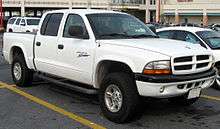
Gone for 2000 was the 8-foot bed on the regular cab, but new for this year was the Quad Cab. Four-door Quad Cab models had a slightly shorter bed, 63.1 in (1602 mm), but riding on the Club Cab's 130.9 in (3325 mm) wheelbase. The Quad Cab featured a full-sized flip up rear seat to provide room for three passengers in the back or much dry, interior room for cargo. The aging 5.2 L Magnum V8 was replaced by a new high-tech 4.7 L SOHC PowerTech V8 this year, and the new 45RFE automatic transmission was introduced.
A fairly extensive revision of the Dakota's interior was made in 2000 for 2001 year models, including a completely redesigned dash, door panels, and revised seats. Other minor trim revisions were made, including redesigned aluminum wheels on various models. All vehicles also got new radio options. Only the standard AM/FM radio (with no cassette deck) was discontinued, making an AM/FM radio with a cassette deck standard on all models. AM/FM stereo CD and cassette/CD variants were also available.
The 2002 model was the final year for the four-cylinder engine in the Dakota, as Chrysler ended production of the former AMC design. Most buyers ordered the V6 or V8 engines, which were considerably more powerful and, in the case of the V6, which was made standard for 2003, nearly as fuel-efficient with a manual transmission. Also, an automatic transmission was not available with the four-cylinder. SIRIUS Satellite Radio was also now available as an option, and revised radios with new wiring harnesses could accommodate this new feature. A CD changer radio was also available, eliminating the need for a separately mounted unit located elsewhere inside the truck. The drivers could load up to six discs into the unit at a time, and could switch out the discs at any time, something they could not do with the old unit. Radio Data System became standard equipment on some radios.
The 2003 model was the end of the old OHV V6 and the big R/T V8; the 2004 model year vehicles were available with a new 3.7 L Magnum V6 engine to go along with the 4.7 L V8 variant.
In 2004, the cassette deck option was discontinued, and a CD player became standard equipment on all models.
This generation was also assembled and sold in Brazil from 1998 to 2001.
The IIHS gave this generation a 'Poor' rating in the frontal offset crash test.[6]
Trim levels
The 1997 to 2004 Dodge Dakota was available in several different trim levels:
The ST served as the base model of the Dakota. It included features such as an A/M-F/M stereo (later with cassette player) and a four-speaker sound system, vinyl-trimmed seating surfaces, front (or front and rear) bench seats, styled steel fifteen-inch (later sixteen-inch) wheels, and vinyl flooring. It also included, and was only available with, the 3.9L (later 3.7L) V6 engine. The ST was also not offered as a four-door Quad Cab model.
The Sport served as the "step-up" Dakota model. It added the following features to the ST model: an A/M-F/M stereo with cassette player (later, a single-disc CD player), cloth seating surfaces, sport-styled alloy wheels, and carpeted flooring. It was available with all engines except for the high-performance 5.9L V8 engine.
The SXT, introduced for model year 2001, served as the "mid-range" Dakota model. It added the following features to the Sport model: an A/M-F/M stereo with single-disc CD player, air conditioning, power windows and door locks with keyless entry (available as an option), and a premium interior. It was available with all engines except for the high-performance 5.9L V8 engine. An SXT Plus model was available that added "value" features such as an A/M-F/M stereo with cassette and single-disc CD players with integral CD changer controls, a premium cloth interior, and sixteen-inch alloy wheels mounted on sixteen-inch tires.
The SLT was the "top-line" Dakota model from late 2000. It added the following features to the SXT model (2001 to 2004 model years) or the Sport model (1997 to 2000 model years): power windows and door locks (Sport only) with keyless entry, a premium interior (Sport only), and premium-styled alloy or chrome-clad wheels. It was available with all available engines on the Dakota. An SLT Plus Package was available that added "value" features to the SLT model, such as sixteen-inch alloy wheels, sixteen-inch tires, an A/M-F/M stereo with cassette and CD players (and integral CD changer controls on 2001 to 2004 year models), a premium cloth interior, and more "upscale" features.
The R/T, otherwise known as the 5.9 R/T was known as the "high-performance" and "top-line" Dakota model from 1997 to 2000. It added the following features to the SLT model: sport front seats, sport-styled chrome-clad wheels, larger performance-rated tires, an A/M-F/M stereo with cassette and single-disc CD players, a six-speaker Infinity amplified premium audio system, and the high-performance 5.9L V8 engine. It was available in all available Dakota models except for the 4-Door Quad Cab model, which was introduced after the R/T or 5.9 R/T was discontinued.
Engines
- 1997–2002 - 2.5 L (150 cu in) AMC I4, 120 hp (89 kW)
- 1997–2003 - 3.9 L (238 cu in) Magnum V6, 175 hp (130 kW)
- 1997–1999 - 5.2 L (318 cu in) Magnum V8, 225 hp (168 kW)
- 1998–2003 - 5.9 L (360 cu in) Magnum V8, 250 hp (186 kW)
- 1999–2001 - 2.5 L (152.5 cu in) VM-425 OHV I4, 114 hp (85 kW) (Brazil)
- 2000–2004 - 4.7 L (287 cu in) PowerTech V8, 230 hp (172 kW)
- 1997-2004 - 3.7 L (226 cu in) Magnum V6, 210 hp (157 kW)[7]
Third generation (2005–2011)
| Third generation | |
|---|---|
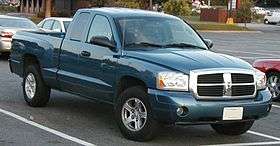 | |
| Overview | |
| Also called | Ram Dakota (2009–2011) |
| Production | August 2004 – 2011 |
| Model years | 2005–2011 |
| Designer | Cliff Wilkins (2001) |
| Body and chassis | |
| Body style | 4-door pickup truck |
| Platform | ND |
| Related | Mitsubishi Raider Dodge Durango |
| Powertrain | |
| Engine | 3.7 L (226 cu in) Magnum V6 4.7 L (287 cu in) Magnum V8 |
| Transmission | 4-speed 42RLE automatic 5-speed 545RFE automatic 6-speed Getrag 238 manual |
| Dimensions | |
| Wheelbase | 131.3 in (3,335 mm) |
| Length | 218.8 in (5,558 mm) |
| Width | 76.4 in (1,941 mm) |
| Height | Club Cab: 68.6 in (1,742 mm) Quad Cab: 68.7 in (1,745 mm) |
The redesigned 2005 Dakota still shared its platform with the new Dodge Durango SUV (which is now similar to the Ram platform). This model is 3.7 in (94 mm) longer and 2.7 in (69 mm) wider, and features a new front and rear suspension, and rack-and-pinion steering. This new generation model also reverted to five-lug wheels from the prior generation's six-lug wheels due to cost and assembly time saving measures. The Dakota is built at the Warren Truck Assembly plant in Warren, Michigan.
A V6 and two V8 engines were available: The standard engine is a 3.7 L Magnum V6; the two 4.7 L V8 engines are the standard Magnum V8 and the V8 High Output or HO. The 3.7 L V6 produces 210 hp (157 kW) and 235 lb⋅ft (319 N⋅m) of torque. The standard-output 4.7 L V8 produces 230 hp (172 kW) and 295 lb⋅ft (400 N⋅m) of torque. The high-output 4.7 L V8 produces 260 hp (194 kW) and 310 lb⋅ft (420 N⋅m) of torque. Both the 3.7 L and standard output 4.7 L V8s were available with the six-speed manual transmission in 2005 and 2006. For 2007, that option was deleted on the V8 models.
In addition to a refresh of the Dakota's styling, this generation was not offered in a regular cab model. Only the club cab and quad cab configurations were available. The Dakota R/T returned in late 2005 for the 2006 year model, but only with cosmetic modifications. Despite the "R/T" moniker which signifies "Road and Track", the newest Dakota R/T was simply an option package, characterized by a nonfunctional hood scoop, exclusive gauge cluster, and hockey stick-style side stripes. The package was available on both two- and four-wheel drive models.

The facelifted third-generation Dakota was unveiled at the 2007 Chicago Auto Show. The Dakota received another facelift and interior upgrade along with a few other upgrades, including built-in cargo-box utility rails, heated bench seats, best-in-class towing (up to 7,050 lb (3,198 kg)), the largest and longest standard bed in the class, and the largest mid-size truck cab. Its new 4.7-liter V8 produces 310 hp (231 kW) and 330 lb⋅ft (447 N⋅m) of torque. The standard engine remained the 3.7-liter V6 with 210 hp (157 kW) and 235 lb⋅ft (319 N⋅m) of torque. Production began in August 2007.
As of 2010, the Dakota was considered a part of the Ram lineup. However, the "Dodge" emblem still existed on the tailgate, and the truck was interchangeably referred to as a Ram Dakota or Dodge Dakota. Its Mitsubishi Raider sibling was discontinued in 2009.

The IIHS gave this generation a 'Good' rating in the frontal offset crash test.[8]
Models
Throughout its production run, the 2005 to 2010 Dodge Dakota was available in three basic models:
The ST served as the base Dakota model. It included the following features: sixteen-inch styled steel wheels, sixteen-inch tires, vinyl-trimmed seating surfaces, manual windows and door locks, an A/M-F/M stereo with a single-disc CD player (later, single-disc CD/MP3 player) and auxiliary audio input jack (on most models), a four-speaker sound system, air conditioning, and the 3.7L "Power-Tech" V6 engine, which was the only available engine on the ST model.
The SLT served as the "mid-level" Dakota model. It added the following features to the base ST model: sixteen-inch sport-styled alloy wheels, cloth seating surfaces, and power windows and door locks with keyless entry. The SLT was available with any engine offering on the Dakota. A Big Horn (all states other than Texas), or Lonestar (Texas Only) Package was also available for the SLT model, which included "value-added" features, as was an SXT Package that added a color-keyed front grille, color-keyed front and rear bumpers, and sport cloth seating surfaces.
The Laramie, otherwise known as the SLT Laramie, was the "top-line" Dakota model. It added the following features to the "mid-level" SLT model: seventeen-inch chrome-clad alloy wheels, seventeen-inch tires, an A/M-F/M stereo with a six-disc, in-dash CD/MP3 changer and auxiliary audio input jack (on most models), a premium Infinity (later Alpine) six-speaker amplified audio system, leather-trimmed heated seating surfaces, power front seats, a security system, a five-speed automatic transmission, and the base 4.7L "Power-Tech" V8 engine, though the high-output version of the same engine was also available on the Laramie or SLT Laramie.
Discontinuation
The third-generation Dakota was discontinued in 2011, with the last unit coming off the assembly line on August 23, 2011, ending the truck's 25-year run.[9] As of 2011, according to Sergio Marchionne, the CEO of Chrysler Group, the Dakota will probably not be replaced by a similar vehicle, mostly due to declining popularity of compact trucks on the North American market (see Ford Ranger for similar outcome).[9] Another problem was that buyers complained that the smaller pickup was not priced lower than the full-sized Ram 1500; nevertheless, the Dakota's return continues to be reported since 2012.[10][11] Fiat Chrysler Automobiles announced in September 2014 an agreement with Mitsubishi Motors to codevelop the next-generation Mitsubishi L200 to be sold globally by both companies. It is sold as RAM 1200 in some Middle Eastern countries.[12]
Sales
| Calendar year | US sales |
|---|---|
| 1999[13] | 144,148 |
| 2000 | 177,395 |
| 2001[14] | 154,479 |
| 2002[15] | 130,712 |
| 2003 | 111,273 |
| 2004[16] | 105,614 |
| 2005 | 104,051 |
| 2006[17] | 76,098 |
| 2007 | 50,702 |
| 2008[18] | 26,044 |
| 2009[19] | 10,690 |
| 2010[20] | 13,047 |
| 2011[21] | 12,156 |
| 2012[22] | 490 |
References
- "Cars Only Bob Lutz Remembers: The Dodge Dakota Convertible - The Truth About Cars". The Truth About Cars. 2011-09-06. Retrieved 2018-05-03.
- "Cujo317 1992 Dodge Dakota Regular Cab & Chassis Specs, Photos, Modification Info at CarDomain". CarDomain.com. Retrieved 9 April 2019.
- "Dakota Warrior Page". www.oocities.org. Retrieved 9 April 2019.
- "Lil' Red Express - Page 2 - Dakota Durango Forum". www.dakota-durango.com. Retrieved 9 April 2019.
- "1992 dakota warrior - Dodge Dakota Forum". www.dodgedakota.net. Retrieved 9 April 2019.
- "IIHS-HLDI:Dodge Dakota regular cab". Insurance Institute for Highway Safety. Retrieved July 10, 2012.
- "2006 Dodge Dakota Specifications" (PDF). Chrysler Media. DaimlerChrysler. Archived from the original (PDF) on April 2, 2013. Retrieved April 26, 2015.
- "IIHS-HLDI:Dodge Dakota crew cab". Insurance Institute for Highway Safety. Retrieved July 10, 2012.
- "Chrysler to stop Dakota production". The Detroit News. August 20, 2011. Archived from the original on August 24, 2011. Retrieved August 24, 2011.
- "The 2016 Dodge Dakota pickup truck". Allpar.com. Retrieved April 25, 2015.
- Williams, Mark (January 9, 2012). "The Next Dodge Dakota: More Intel From Chrysler CEO". Retrieved April 25, 2015.
- "RAM 1200 2019 in UAE". Yallamotor.com. Retrieved 9 April 2019.
- "Chrysler Group Announces Year-End and December Sales". Theautochannel.com. Retrieved June 25, 2009.
- "Chrysler Group Reports U.S. December Sales". Theautochannel.com. Retrieved June 25, 2009.
- "Chrysler Group Reports December 2003 Sales Increase of 2 Percent". Theautochannel.com. November 17, 2004. Retrieved June 25, 2009.
- "Chrysler Group 2005 U.S. Sales Rise 5 Percent, Highest Since 2000; December Sales Decline in Line with Overall Industry". PR Newswire. Archived from the original on February 4, 2009. Retrieved June 25, 2009.
- "Total Chrysler LLC December 2007 Sales Up 1 Percent on the Strength of Retail; Demand..." Reuters. January 3, 2008. Archived from the original on February 3, 2009. Retrieved June 25, 2009.
- "Chrysler LLC Reports December 2008 U.S. Sales". PR Newswire. Archived from the original on February 4, 2009. Retrieved June 25, 2009.
- "Chrysler Group LLC December 2009 Sales". CheersandGears.com. Retrieved January 5, 2010.
- "Chrysler Group LLC December 2010 Sales". CheersandGears.com. Retrieved January 4, 2011.
- "Chrysler sales shoot up 37% (26% for 2011)". allpar.com. Archived from the original on January 10, 2012. Retrieved January 4, 2012.
- "Chrysler Group LLC Reports December 2012 U.S. Sales Increased 10 Percent" (Press release). Chrysler Group LLC. January 3, 2013. Retrieved January 4, 2013.